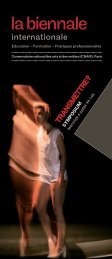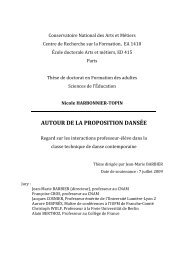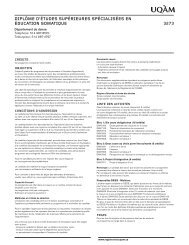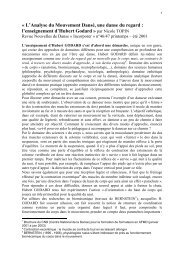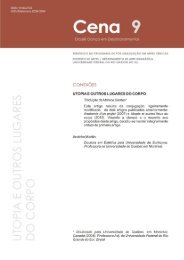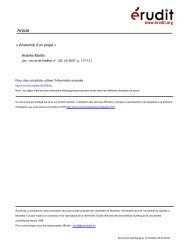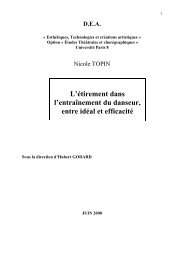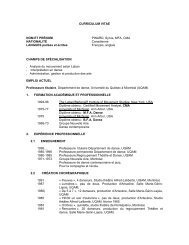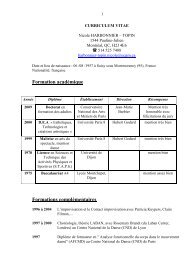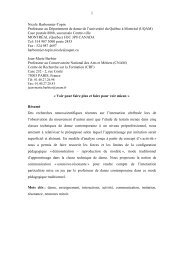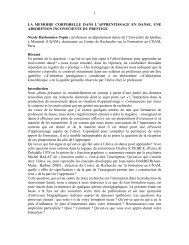Day 2 - Département de danse - UQAM
Day 2 - Département de danse - UQAM
Day 2 - Département de danse - UQAM
You also want an ePaper? Increase the reach of your titles
YUMPU automatically turns print PDFs into web optimized ePapers that Google loves.
celles-ci. En terminant, la notoriété internationale <strong>de</strong> maintes compagnies et artistes québécois a fait en sorte <strong>de</strong> multiplier les<br />
étu<strong>de</strong>s sur le théâtre québécois produites par <strong>de</strong>s chercheurs étrangers. Quel est leur impact sur le développement du champ<br />
et entrainent-elles la remise en question <strong>de</strong>s présupposés habituels <strong>de</strong> certains chercheurs québécois ? Telles sont les<br />
interrogations qui parcoureront les communications <strong>de</strong>s invités à cette séance qui vise à faire connaître aux collègues du<br />
Canada anglais les tangentes que l’on peut observer dans la recherche actuelle en étu<strong>de</strong>s théâtrales au Québec.<br />
d) Classified Performances: Staging Genres, Species, “Mash-Ups” Fine Arts 103<br />
Open Panel Mo<strong>de</strong>rator: Kate Bessey (University of Victoria)<br />
“The Politics of Theatrical Genres in China’s Post-1949 Dramatic Reform.” Siyuan Liu<br />
(University of British Columbia)<br />
There are over two hundred genres of indigenous Chinese theatre, ranging from the nationally dominant jingju (Beijing opera),<br />
to ancient genres such as kunqu, to more recent varieties that emerged only in the twentieth century. While recent studies of<br />
communist China’s post-1949 dramatic reform have largely focused on the campaign’s adverse effect on jingju and a few<br />
other nationally influential genres, a careful study of official documents suggest that the reform’s damage to less established<br />
genres were oftentimes more drastic and fundamental. To start with, state control of the theatre companies for these genres—<br />
often in the form of state-owned mo<strong>de</strong>l companies of the best actors—started much earlier than jingju, making it far easier for<br />
cultural authorities to directly influence these genres’ performance techniques and repertoire selection through the star<br />
performers. Secondly, since the pre-1949 repertoire of many newer genres focused on contemporary stories of the middle and<br />
lower classes which were consequently <strong>de</strong>emed as <strong>de</strong>rogatory to the laboring masses, most of these plays were censored in<br />
the early 1950s. In the worst cases, some genres lost most of their pre-1949 repertoire and were directed to only perform<br />
newly created plays. Thirdly, for reasons related to their performance conventions, some genres were forced to stop<br />
performance or merge with others. For example, a few genres that relied mostly on improvisation rather than written scripts<br />
were <strong>de</strong>emed evolutionarily backward, in addition to being elusive to censorship. These genres were forced to adopt written<br />
scripts or otherwise face <strong>de</strong>nial of company registration and performance license, resulting in the <strong>de</strong>mise of improvisation as a<br />
significant performance convention—especially for farcical theatre—and, in certain cases, forced merger with more “advanced”<br />
genres. In other cases, some theatrical forms that grew out of a particular dialect or regional music—and therefore had a small<br />
audience base—were or<strong>de</strong>red to merge with nearby genres by cultural officials either out of personal taste or for the sake of<br />
administrative convenience.<br />
Based on extensive archival research in major Chinese cities, theatrical advertisement, and contemporary newspaper and<br />
magazine articles, this paper seeks to not only expand our un<strong>de</strong>rstanding of China’s dramatic reform but also bring the issue<br />
of genre politics to the study of authority and theatre.<br />
“‘Something truly original’: Exploring the Edges of Performance and Reality in Vancouver’s<br />
Electric Company Theatre’s Tear the Curtain.” Emily A. Rollie (University of Missouri)<br />
In 2010, Vancouver’s Electric Company Theatre premiered Tear the Curtain, a surreal, film noir tale set in 1930’s Vancouver<br />
and in which Vancouver’s historic Stanley Theatre—a venue originally built as a vau<strong>de</strong>ville house but opened as a cinema—<br />
figured prominently. Directed by Electric Company co-foun<strong>de</strong>r and award-winning director Kim Collier, Tear the Curtain earned<br />
high praise when it opened in Vancouver for its innovative combination of film and live performance and its stunning visual<br />
story. In fall of 2012, the production was re-mounted and transported across the country for its Toronto premiere at Canadian<br />
Stage’s Bluma Appel Theatre. In the words of Globe and Mail theatre/film critic Martin Morrow, Tear the Curtain is “a full on<br />
mash up of theatre and film,” as this unique production not only segues seamlessly from one medium to the other but also<br />
comments, or perhaps more accurately theorizes, on the tension that exists between film and theatre, ultimately prompting the<br />
audience to question what is truly real—both in life and in performance.<br />
As part of my dissertation research on Canadian women directors and their work, I traveled to Vancouver and Toronto in<br />
September and October 2012 to observe rehearsals of Tear the Curtain and interview Collier about the production. Using my<br />
interview with Collier, first-hand observations of the rehearsal and production process, and available critical reviews from both<br />
Vancouver and Toronto, this paper explores the historical origins of this <strong>de</strong>ci<strong>de</strong>dly Vancouver-based story as well as<br />
documents the innovative and “cutting edge” methods employed by Collier and the Electric Company Theatre to create the<br />
production. Further, by consi<strong>de</strong>ring the critical responses to both the Vancouver and Toronto productions, this paper will<br />
consi<strong>de</strong>r how this West Coast story speaks to both its geographical roots and a larger sense of Canadian (performance)<br />
history.<br />
“Nuances of Play: Seeking the Inter-species in Inter-species Performance.” Kimber Si<strong>de</strong>r<br />
(University of Guelph)<br />
The question of animals and performance <strong>de</strong>fines the crossroads of the aca<strong>de</strong>mic fields of Human/Animals Studies and<br />
Performance Studies, giving rise to the proposition of inter-species performance. But are all performances that integrate<br />
animals into their productions inter-species? Or are there different manners of collaboration?<br />
My research focuses on human/equine interaction, and the reciprocally performative manner through which humans and<br />
horses relate. It is through performance that humans predominantly experience horses. The positioning of horses in relation to<br />
humans is unique in that horses are one of the few animals that partner with humans, not merely as companion species, but<br />
through a connection based on symbiotic performance. However, little research has been done to expand the un<strong>de</strong>rstandings<br />
12



